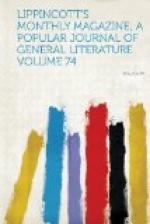in colonies how much importance is attached to
the possession of a good public library, and how
fond, as a rule, colonists are of books. In a
new settlement other shops may be ill supplied, but
there is always a good bookseller’s, and
all books are to be bought there at pretty nearly
the same prices as in England. Here each
volume costs precisely the same as it would in London,
and it would puzzle ever so greedy a reader to
name a book which would not be instantly handed
to him.
The museum is well worth a visit of many more hours than we could afford minutes, and, as might be expected, contains numerous specimens of the Bok family, whose tapering horns and slender legs are to be seen at every turn of one’s head. Models are there also of the largest diamonds, and especially well copied is the famous “Star of South Africa,” a magnificent brilliant of purest water, sold here originally for something like twelve thousand pounds, and resold for double that sum three or four years back. In these few hours I perceive, or think I perceive, a certain soreness, if one may use the word, on the part of the Cape Colonists about the unappreciativeness of the English public toward their produce and possessions. For Instance, an enormous quantity of wine is annually exported, which reaches London by a devious route and fetches a high price, as it is fairly entitled to do from its excellence. If that same wine were sent direct to a London merchant and boldly sold as Cape wine, it is said that the profit on it would be a very different affair. The same prejudice exists against Cape diamonds. Of course, as in other things, a large proportion of inferior stones are forced into the market and serve to give the diamonds that bad name which we all know is so fatal to a dog. But it is only necessary to pretend that a really fine Cape diamond has come from Brazil to ensure its fetching a handsome price, and in that way even jewelers themselves have been known to buy and give a good round sum, too, for stones they would otherwise have looked upon with suspicion. Already I have seen a straw-colored diamond from “Du Zoit’s pan” in the diamond-fields cut in Amsterdam and set in London, which could hold its own for purity, radiance and color against any other stone of the same rare tint, without fear or favor; but of course such gems are not common, and fairly good diamonds cost as much here as in any other part of the world.
The light morning mists from that dampness of yesterday have rolled gradually away as the beautiful sunshine dried the atmosphere, and by midday the table-cloth, as the colonists affectionately call the white, fleece-like vapor which so often rests on their pet mountain, has been folded up and laid aside in Cloudland for future use. I don’t know what picture other people may have made to their own minds of the shape and size of Table Mountain, but it was quite a surprise and the least little bit in the world of a disappointment




